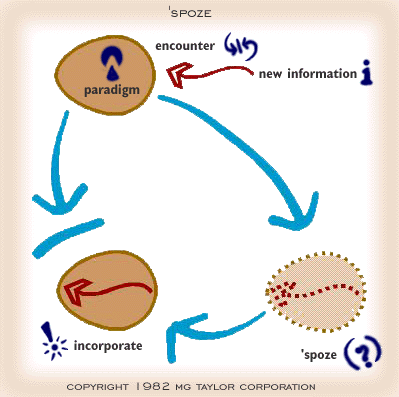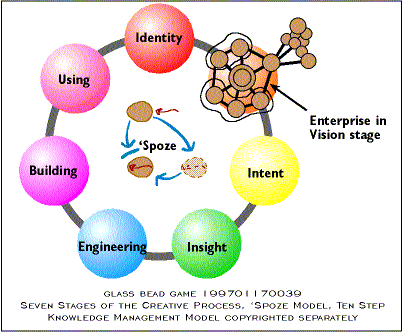|
|
 |
Modeling Language Spotlight
S'poze
January 13, 1997 |
Editor's note: To get the most out of this article, the
reader should be familiar with the models Scan Focus Act, Seven Stages of the Creative Process and
Ten Step Knowledge
Management. By the way, 'Spoze is short for "Suppose".
Like the other models of the MG Taylor Modeling Language,
the S'poze Model is protected by copyright. You can use it only by meeting
these four conditions.
S'poze and the Creative Process
At first glance, the S'poze model seems a duplicate of the Scan Focus Act model. After all, the act of information approaching
a system to create an Encounter sounds a lot like the Scan phase [except in
this case, it's the incoming information that's proactive, not the system doing
the scanning]. The idea of testing the implications of the new information interacting
within the existing system--the actual S'poze--sounds like Focus. And the decision
whether or not to actually Incorporate the information into the system seems
like Act. These phases are shown in the diagram below:

But S'poze and Scan Focus Act are not duplicate models, rather,
S'poze links the creative process inherent in Scan Focus Act with the knowledge
management process of the Ten Step Knowledge Management model. S'poze deals directly
with the management of information as a whole in the total messaging event.
[A messaging event refers to the encoding, transduction, transmission, reception,
transduction, decoding, association, memory and deciding connected with a message
or series of messages and their effect upon some living system.]
Stages and Elements
First let's look at the various stages and elements of the model and then return
to developing the case for S'poze as a link between the Creative Process and
the Ten Step Knowledge Management model. S'poze has two elements (the Paradigm
and the New Information) and three stages (Encounter, S'poze, and Incorporate).
| glyph info |
Stage/Element |
Description |
 |
Encounter |
At this stage, the system's current Paradigm meets
up with a high information messaging event. This means, simply, that
the system is experiencing the effect of New Information that does not
fit into its current model of how things work--its Paradigm. And it
means that the potential effect of this information is of such a magnitude
as to compel a conscious decision for handling it. Either it represents
a threat and the system must learn new strategies for thwarting it,
or it contains a potential benefit and the system must learn how to
take advantage of it. |
 |
New Information |
Systems are receiving all kinds of messages from other
systems and the environment in general. Messages are neutral. They do
not contain information. Rather, information is the result of a system's
interpretation of a message, including whatever meaning it assigns to
the message based on past experience. This meaning--or message in context
of associated experiences--is what we call information. The measure
of information is proportional to its uncertainty, or surprise. The
more surprising the message, the more information it contains. Most
messaging events are devoid of information, either because they are
filtered out, or because they bear messages whose content is expected
by the receiving system. |
 |
Paradigm |
For a living system to make decisions, it must be able
to compare the nature of sensory input that it receives to some model
that predicts probable future outcomes based on stored previous experiences
involving that input. This memory may be inherited genetic storage,
or learned mental storage. In either case, it represents a guide to
success given a variety of situations. The sum total of these situations
and the guidelines stored in the system comprise its paradigm. |
 |
S'poze |
It is not advisable for a system to accept any and
all New Information to add to its Paradigm. The process of modeling
enables the system to play "what if" without actually engaging
in a potentially threatening experience. |
 |
Incorporation |
If the results of the simulation seem favorable, the
system may incorporate the New Information into its Paradigm and begin
making decisions based upon this new mixture. |
An Example
Let's walk through an example to develop a little understanding of how the model
works. Again, like Scan Focus Act, this is a naturally occurring model; we all
use it every day. Our purpose in studying it is not so much to learn to incorporate
it into our inventory of processes but to raise its activity to a level of conscious
awareness.
A common example used in describing Scan Focus Act will also serve
here--the story of the lioness hunting wildebeest on the plains of the Serengeti.
The lioness Scans the herd for a potential meal, Focuses on likely candidates
and then Acts explosively to chase one down. That's a simple description of
the process from the vantage point of creativity. But what's going on from a
signal processing standpoint?
New information about the herd and perhaps other animals lurking
about, is constantly streaming into the lioness' senses. This new information,
according to James Miller's Living Systems model is processed by
a function called the Associator. The Associator compares the input to patterns
and models in Memory, searching for overlaps that trigger the Decider function
to initiate some physiological activity in response. New information that enters
the system as a result of this response is fed back into Memory to update the
pattern. This trio of functions--Associator, Memory and Decider--represents
the learning process. Thus, the lioness learns how to spot potential meals among
the animals in the herd. It also learns different strategies for approaching
and chasing its meal.
The activity of the Associator is one representation of playing
S'poze. The Associator is trying to build little vignettes (or scenarios) of
future predictions based on a comparison of new information and old memories.
It's a little like thinking ahead in chess.
The Case for S'poze as a Linking Model
Imagine the Creative Process a huge playing board, with its seven circles representing
the zones of play. Further, imagine the enterprise as a knowledge management
engine, continuously running through cycles of events, documentation, storage
in a K-base, distribution, design. In the diagram below, the enterprise is in
the Vision stage of the Creative Process. How will it manage the receipt of
new information at this stage? The importance of new information in the Vision
stage should be obvious. Enterprises that have robust processes for handling
such information designed into their behavior will excel at this stage. And
the process for handling the information is precisely the S'poze process.

The enterprise uses S'poze in each stage of the Creative Process
in a similar manner. A subtle point to emphasize is that the enterprise also
uses S'poze to process information in the transition from one stage to another.
The team that brings an idea through Vision will not be the same team that takes
the idea through Intent. Even if its membership remains the same, the thinking
and behavior of its members changes from stage to stage. Part of this change
is due to shifts in learning and part is due to individual preferences for one
stage over another. In any case, an idea that seems clear and solid in Vision
may teeter on the brink of extinction as it enters Intent unless the group at
that point is capable of playing S'poze.
So not only must the enterprise be designed to manage the Ten
Step Knowledge Management process, but it must employ the S'poze model to manage
new information processing and learning within each stage of the Creative Process
and between stages as well.
Strategies for Playing S'poze
It may seem from looking at the model that the activity of S'poze is played
outside of the host system, in some safe, confined area. This is not the case.
S'poze is played in real life only with an element of risk. At the minimum,
the activity will consume time and divert attention. It's always possible that
when new information is admitted to a system it will behave in a viral manner,
disrupting the organism's homeostasis. S'poze is always played inside the enterprise,
even if in a safe, protected area, such as a planning session. S'poze doesn't
happen somewhere "out there." Nevertheless, playing S'poze is required
for the organization to continue to learn, and also to spawn offspring that
can successfully adapt to changing conditions in the wider ecosystem. The risk
is unavoidable. Among most species of life, the survival rates of progeny are
somewhat low. The survival of mutations is usually much lower.
The most complete way for an enterprise to play S'poze is to create
offspring, preferably through "recombination of DNA." In nature this
happens when a male and female of a species recombine their genetic material
to produce offspring that will inhabit perhaps a radically improved niche on
the species' fitness landscape. In enterprises, recombination occurs when two
or more organizations share ideas and strengths to form a separate project or
enterprise for the purpose of testing the quality of the ideas in action. You
can simulate all you want, but at some point you really just have to do it to
know whether it will succeed.
This is why DesignShop® events demand such broad representation
from all of the components of the Business of Enterprise model--customers, management, investors,
producers. The entire value chain, and sometimes even competitors should be
included. The richer the diversity of participants, the better chance the outcome
has of success. Of course the diversity is not assembled arbitrarily. Participants
must all have some stake in the outcome; they can't be casual participants or
observers.
 
copyright © 1997, MG Taylor Corporation.
All rights reserved
copyrights,
terms and conditions
19970113161911.web.bsc
|



















